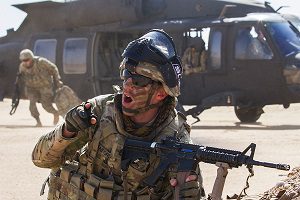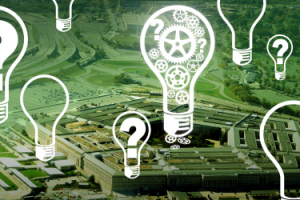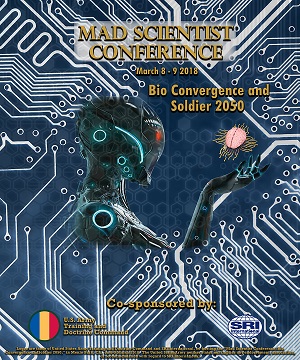[Editor’s Note: The U.S. Army Training and Doctrine Command (TRADOC) co-hosted the Mad Scientist Bio Convergence and Soldier 2050 Conference with SRI International on 8–9 March 2018 at their Menlo Park campus in California. This conference explored bio convergence, what the Army’s Soldier of 2050 will look like, and how they will interact and integrate with their equipment. The following post is an excerpt from this conference’s final report.]

While the technology and concepts defining warfare have continuously and rapidly transformed, the primary actor in warfare – the human – has remained largely unchanged. Soldiers today may be physically larger, more thoroughly trained, and better equipped than their historical counterparts, but their capability and performance abilities remain very similar.
 These limitations in human performance, however, may change over the next 30 years, as advances in biotechnology and human performance likely will expand the boundaries of what is possible for humans to achieve. We may see Soldiers – not just their equipment – with superior vision, enhanced cognitive abilities, disease/virus resistance, and increased strength, speed, agility, and endurance. As a result, these advances could provide the Soldier with an edge to survive and thrive on the hyperactive, constantly changing, and increasingly lethal Multi-Domain Battlespace.
These limitations in human performance, however, may change over the next 30 years, as advances in biotechnology and human performance likely will expand the boundaries of what is possible for humans to achieve. We may see Soldiers – not just their equipment – with superior vision, enhanced cognitive abilities, disease/virus resistance, and increased strength, speed, agility, and endurance. As a result, these advances could provide the Soldier with an edge to survive and thrive on the hyperactive, constantly changing, and increasingly lethal Multi-Domain Battlespace.

In addition to potentially changing the individual physiology and abilities of the future Soldier, there are many technological innovations on the horizon that will impact human performance. The convergence of these technologies – artificial intelligence (AI), robotics, augmented reality, brain-machine interface, nanotechnologies, and biological and medical improvements to the human – is referred to as bio convergence. Soldiers of the future will have enhanced capabilities due to technologies that will be installed, instilled, and augmented. This convergence will also make the Army come to terms on what kinds of bio-converged technologies will be accepted in new recruits.
The conference generated the following key findings:

• The broad advancement of biotechnologies will provide wide access to dangerous and powerful bioweapons and human enhancements. The low cost and low expertise entry point into gene editing, human performance enhancement, and bioweapon production has spurred a string of new explorations into this arena by countries with large defense budgets (e.g., China), non-state criminal and terrorist organizations (e.g., ISIS), and even super-empowered individuals willing to subject their bodies to experimental and risky treatments.

• Emerging synthetic biology tools (e.g., CRISPR, Talon, and ZFN) present an opportunity to engineer Soldiers’ DNA and enhance their performance, providing greater speed, strength, endurance, and resilience. These tools, however, will also create new vulnerabilities, such as genomic targeting, that can be exploited by an adversary and/or potentially harm the individual undergoing enhancement. Bioengineering is becoming easier and cheaper as a bevy of developments are reducing biotechnology transaction costs in gene reading, writing, and editing. Due to the ever-increasing speed and lethality of the future battlefield, combatants will need cognitive and physical enhancement to survive and thrive.

• Ensuring that our land forces are ready to meet future challenges requires optimizing biotechnology and neuroscience advancements. Designer viruses and diseases will be highly volatile, mutative, and extremely personalized, potentially challenging an already stressed Army medical response system and its countermeasures. Synthetic biology provides numerous applications that will bridge capability gaps and enable future forces to fight effectively. Future synthetic biology defense applications are numerous and range from sensing capabilities to rapidly developed vaccines and therapeutics.

• Private industry and academia have become the driving force behind innovation. While there are some benefits to this – such as shorter development times – there are also risks. For example, investments in industry are mainly driven by market demand which can lead to a lack of investment in areas that are vital to National Defense but have low to no consumer demand. In academia, a majority of graduate students in STEM fields are foreign nationals, comprising over 80% of electrical and petroleum engineering programs. The U.S. will need to find a way to maintain its technological superiority even when most of the expertise eventually leaves the country.

• The advent of new biotechnologies will give rise to moral, regulatory, and legal challenges for the Army of the Future, its business practices, recruiting requirements, Soldier standards, and structure. The rate of technology development in the synthetic biology field is increasing rapidly. Private individuals or small start-ups with minimal capital can create a new organism for which there is no current countermeasure and the development of one will likely take years. This potentiality leads to the dilemma of swiftly creating effective policy and regulation that addresses these concerns, while not stifling creativity and productivity in the field for those conducting legitimate research. Current regulation may not be sufficient, and bureaucratic inflexibility prevents quick reactive and proactive change. Our adversaries may not move as readily to adopt harsher regulations in the bio-technology arena. Rather than focusing on short-term solutions, it may be beneficial to take a holistic approach centered in a world where bio-technology is interacting with everyday life. The U.S. may have to work from a relative “disadvantage,” using safe and legal methods of enhancement, while our adversaries may choose to operate below our defined legal threshold.
Bio Convergence is incredibly important to the Army of the Future because the future Soldier is the Bio. The Warrior of tomorrow’s Army will be given more responsibility, will be asked to do more, will be required to be more capable, and will face more challenges and complexities than ever before. These Soldiers must be able to quickly adapt, change, connect to and disconnect from a multitude of networks – digital and otherwise – all while carrying out multiple mission-sets in an increasingly disrupted, degraded, and arduous environment marred with distorted reality, information warfare, and attacks of a personalized nature.

For additional information regarding this conference:
• Review the Lessons Learned from the Bio Convergence and Soldier 2050 Conference preliminary assessment.
• Read the entire Mad Scientist Bio Convergence and Soldier 2050 Conference Final Report.
• Watch the conference’s video presentations.
• See the associated presentations’ briefing slides.
• Check out the associated “Call for Ideas” writing contest finalist submissions, hosted by our colleagues at Small Wars Journal.




There are a whole lot simpler ways to make enhanced soldiers: steroids and other chemical enhancements. An unscrupulous regime could use some of the same bio-chemistry that is used to cheat in athletic competition to make units of soldiers with more strength and endurance with only a few years of effort.
Imagine a special ops unit with doctor-supervised use of EPO, creatine, and other similar drugs, much like the Soviet/Russian Olympic competitors. They could plausibly carry more gear and march farther and faster than their competitors.